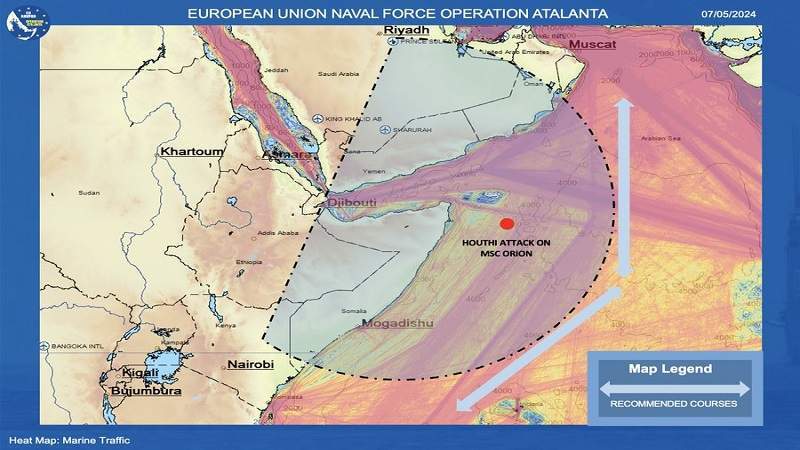Yemen’s Maritime Operations Extend to Indian Ocean, Pose Threat to US, UK, and Israeli Ships

Yemen: Against the backdrop of the declared American and European failure to limit maritime operations supporting the Palestinian people in Yemen, the European Union acknowledged this week the widening scope of danger to ships associated with the Zionist enemy, the United States, and Britain in the Indian Ocean.
The European Union attached a map to the memorandum that clearly showed the expansion of Yemeni maritime operations to the Indian Ocean, covering a wide area that includes Socotra Island and its maritime surroundings, as well as the maritime area opposite the entire Somali coast, extending north to the island of Madagascar.
The European memorandum was based on the qualitative operation announced by the Yemeni Armed Forces at the end of April last year, which targeted the Israeli ship "MSC Orion" in the Indian Ocean.
The memorandum stated, "The ship (MSC Orion) was targeted by an unmanned aerial vehicle 200 nautical miles southeast of Socotra Island, while the ship was sailing northward towards Salalah, Oman."
It added, "This attack confirms that potential attacks can occur in the Indian Ocean at a distance of up to 800 nautical miles from the areas controlled by the Yemeni Armed Forces."
The memorandum proposed the establishment of an alternative maritime route at least 150 nautical miles east of the current shipping lanes, in light of this attack and the assessment of the range of unmanned aerial vehicles and recent statements.
The map included in the statement indicated the new route, in which ships are supposed to avoid approaching the area surrounding Socotra and the area opposite the Somali coast (about 700 nautical miles) and are forced to navigate between the depths of the Arabian Sea and the north of Madagascar.
However, the new route identified by the map is not considered safe for ships heading towards the Zionist enemy, as the defined danger zone on the map is very extensive, confirming that the Yemeni Armed Forces possess advanced capabilities that can reach far distances that cannot be measured based on a single attack. In April of last year, the Armed Forces announced the targeting of the Israeli ship "MSC Grace F," and vessel tracking sites showed that it was sailing off the coast of Kenya, well beyond the range specified by the European "Atalanta" operation.
This is also confirmed by another recommendation included in the European Union memorandum, which advised ships to "randomly modify their speed and course and adopt a more restrictive policy for automatic identification system data," which refers to the falsification and forging of electronic information for the ship, such as its identity and destination. This recommendation clearly indicates that the alternative route proposed by the European Union for ships in the Indian Ocean is not sufficient to avoid Yemen’s operations and that targeted ships must also falsify their data.
However, the process of falsifying the automatic identification system data for ships has already proven to be futile, as the armed forces have been able to target enemy ships in recent months that had changed their route information, turned off their identification devices, and even changed their ownership data to conceal their connection to the Zionist enemy or to the United States and Britain.
The European Union memorandum also stated that "it is important for ships operating in the western Indian Ocean, the Gulf of Aden, and especially those within a 700-nautical-mile distance from the Somali coast, to adhere to recommendations and report any incidents immediately."
This memorandum clearly acknowledges that the Indian Ocean has become a major theater for Yemeni operations supporting Gaza, and that ships relied upon by the Zionist enemy passing through that area are increasingly at risk over time. This means that shipping companies may soon consider halting shipping operations to enemy ports through the Bab-el-Mandeb Strait, as they did in the Red Sea. This will have significant additional implications on the enemy's economy.
The new European memorandum comes in the wake of an official admission of recent shortcomings by the commander of "Aspides," an operation conducted by the European Union in February to support the American enemy's attempt to limit Yemeni operations and protect Zionist navigation. The European commander said that the operation no longer has sufficient warships to continue confronting Yemeni attacks after the successive withdrawal of several European frigates.
In this context, the Danish website "Shipping Watch" reported this week that Lars Jensen, a prominent expert in the maritime shipping industry and former executive at Maersk, said, "Despite the Prosper Guardian (American) and Aspides (European) operations, the data from the Maritime Security Center for the African Century shows a clear and increasing trend in the number of attacks," according to the Danish website specialized in maritime navigation affairs.
Jensen added that "if the goal of the American and European operations is to reduce the risks of Yemeni attacks, no progress has been made," according to the website.
He said, "The data clearly shows that the volume of attacks is constantly increasing despite military presence," noting that about 132 missile and drone attacks have been recorded since last November, according to data from the Maritime Security Center for the African Century.
#Israel #Armed Forces #GazaGenocide About 2 months-
08:28
Our correspondent in Hodeidah: The US-British aggression launched the fourth raid on Hodeidah International Airport
08:26
Our correspondent in Hodeidah: Three raids by the US-British aggression on Hodeidah International Airport
04:43
Palestinian medical sources: 23 martyrs have arrived at Nasser Medical Complex in Khan Younis since the morning due to Zionist massacres.
03:54
Palestinian medical sources: 15 martyrs have been transferred to Nasser Complex since this morning due to the ongoing Israeli aggression on Khan Younis in the southern Gaza Strip.
02:43
UNRWA: Over 560 displaced people in Gaza, including women and children, were killed while sheltering in facilities bearing the UN flag





